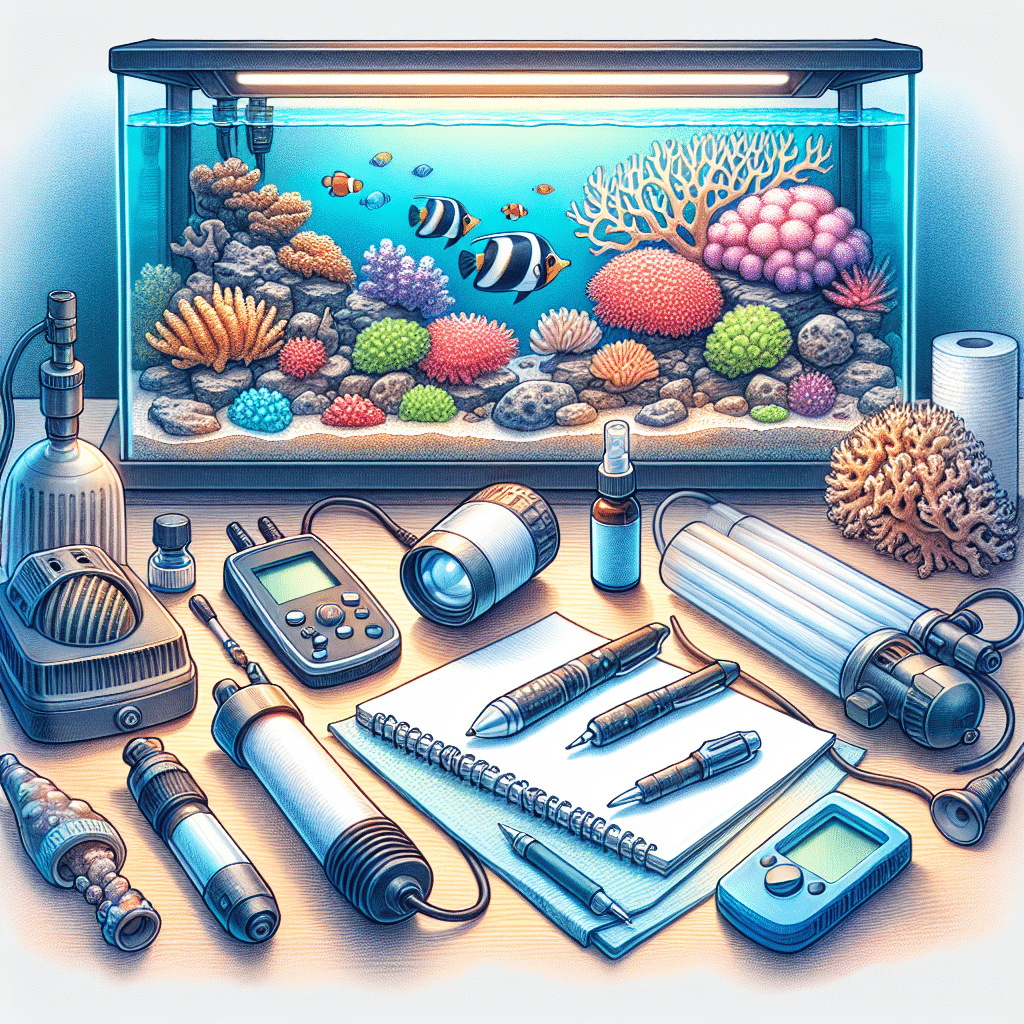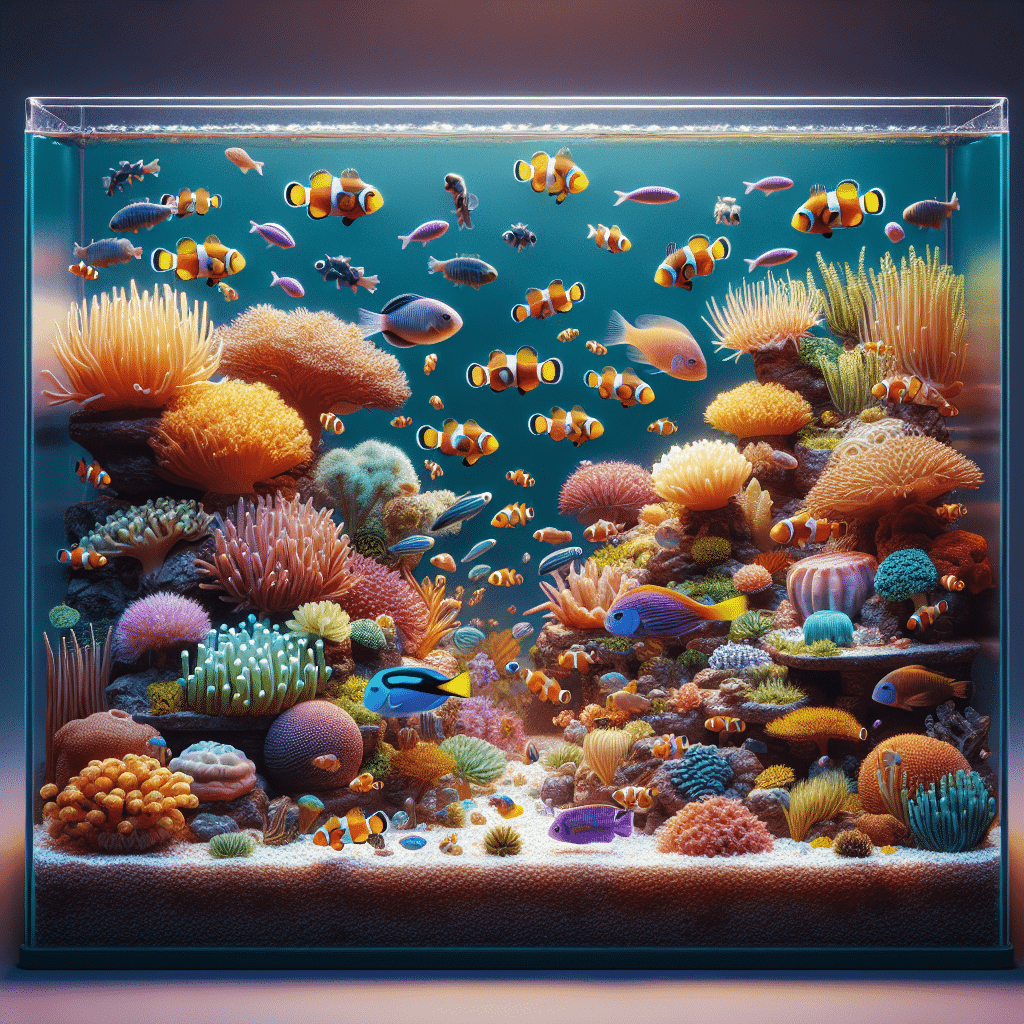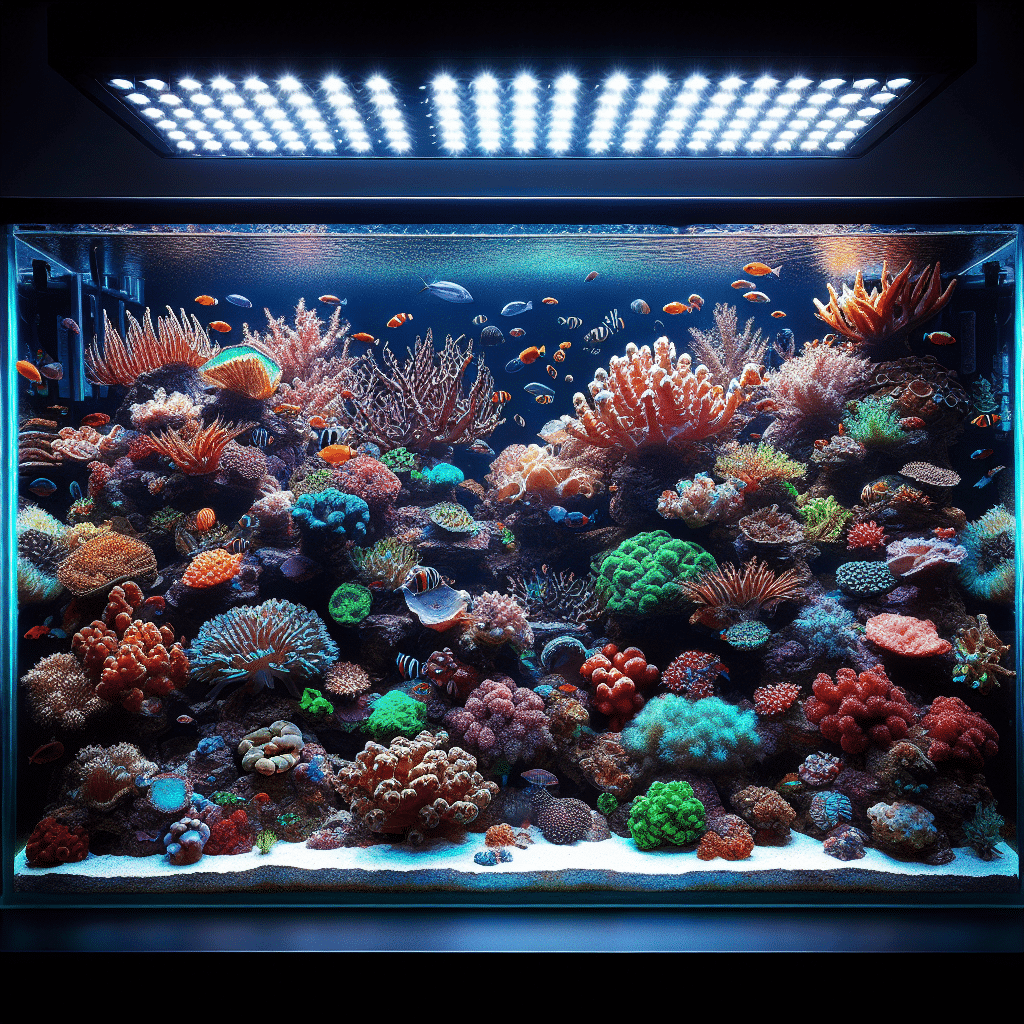Equipment for Nano Reef Tanks
Setting up and maintaining a nano reef tank requires specific equipment to ensure a healthy environment for both fish and corals. This section covers the essential equipment for a 20-gallon nano tank and highlights the importance of protein skimmers.
Essential Equipment for a 20-Gallon Nano Tank
For a successful 20-gallon nano tank, several key pieces of equipment are essential. These items help maintain water parameters and provide a suitable habitat for aquatic life. The following table outlines the primary equipment needed:
| Equipment | Purpose |
|---|---|
| Heater | Maintains stable water temperature |
| Thermometer | Monitors water temperature |
| Powerhead | Circulates water for better filtration |
| Filter | Removes particulate matter and improves water quality |
| Light | Provides necessary lighting for photosynthesis in corals |
| Protein Skimmer | Removes dissolved organics and waste from the water |
These tools are crucial for creating an ideal environment in a nano reef tank, ensuring that both fish and corals thrive. For more details on the setup process, refer to our article on nano reef tank setup.
Importance of Protein Skimmers
Protein skimmers play a vital role in maintaining water quality in a reef tank. They remove dissolved organics, such as fish food, waste, and other organic materials from the water. This process helps prevent the breakdown of these substances into harmful compounds like ammonia, nitrate, and phosphate, which can be toxic to fish and promote algae growth.
The efficiency of protein skimmers in waste removal, along with their low maintenance requirements, makes them a popular choice among saltwater aquarists. The selection of a protein skimmer should consider several factors, including:
- Placement Location: Options include the back of the tank, sump, or all-in-one (AIO) filtration systems.
- Aquarium Size: The skimmer should be appropriately sized for the tank.
- Bioload: This refers to the amount of waste produced by the tank’s inhabitants.
- Pump Type: Options include alternating current (AC) or direct current (DC) powered pumps.
- Recirculating Skimmers: These provide consistent performance through efficient circulation.
Popular brands for protein skimmers include Reef Octopus, Tunze, and AquaMaxx. These brands are known for their reliable internal skimmers, making them suitable for beginners in reef tank maintenance (Bulk Reef Supply).
Understanding the assembly and operation of a protein skimmer can vary in complexity. Some models are straightforward, while others may require more effort to set up. Watching instructional videos and conducting thorough research on the specific skimmer chosen can enhance the assembly and operation experience. For more information on filtration options, check our article on nano reef tank filtration.
Lighting Considerations
Proper lighting is essential for maintaining a healthy and vibrant nano reef tank. Understanding the effects of different colors and choosing the right brands can significantly enhance coral growth and overall tank aesthetics.
Lighting Color Effects
The color of the lighting in a nano reef tank plays a crucial role in the health of corals. Blue lighting is particularly beneficial as it is the most usable color by corals. It promotes photosynthesis and encourages coral growth, while UV and violet lights help enhance fluorescence. Many reef enthusiasts recommend a lighting combination of royal blue, blue, and violets for optimal results (Nano-Reef Forums).
However, achieving the right balance is important. While corals fluorescing under blue lighting can be visually stunning, excessive blue can wash out the appearance of non-fluorescent elements in the tank. Most reef tanks utilize lighting around “20,000K,” which mimics the deeper parts of the photic zone where yellow-red light is minimal.
| Color | Effect |
|---|---|
| Blue | Promotes photosynthesis and coral growth |
| UV | Enhances fluorescence |
| Violet | Supports coral health and vibrancy |
Recommended Lighting Brands
Choosing high-quality lighting equipment is essential for any nano reef tank setup. Here are some recommended brands known for their effectiveness in supporting coral growth:
| Brand | Type | Price Range |
|---|---|---|
| AquaKnight | LED | $60 |
| Kessil | LED | Varies |
| Ecotech Marine | LED | Varies |
| Current USA | LED | Varies |
AquaKnight LED lights are particularly recommended for pico tanks due to their good PAR (Photosynthetic Active Radiation) output and affordability. For more in-depth information on setting up your lighting, explore our article on nano reef tank lighting.
By considering both the color effects and reliable brands, individuals can create a thriving environment for both fish and corals in their nano reef tanks.
Setting Up a Nano Reef Tank
Creating a thriving nano reef tank requires gathering the right equipment to maintain optimal conditions for both fish and corals. Below are the basic and additional recommended items essential for setting up a successful nano reef tank.
Basic Equipment Needed
The fundamental equipment needed for a nano reef tank includes:
| Equipment | Purpose |
|---|---|
| Aquarium | The main container for your reef tank. |
| Powerhead or Wave Maker | Helps circulate water for better oxygenation and nutrient distribution. |
| Refractometer | Measures the salinity of the water. |
| Quality Reef Lighting | Provides the necessary light spectrum for coral growth. |
| Sand (optional) | Creates a natural substrate for the tank unless opting for a bare bottom. |
| RO/DI Water or Distilled Water | Ensures purity and removes harmful contaminants. |
| Reef Aquarium Salt Mix | Provides essential minerals and elements for marine life. |
| Live Rock | Serves as biological filtration and habitat for marine organisms. |
| Filter | Maintains water clarity and quality. |
| Heater | Keeps the water temperature stable for inhabitants. |
These items are crucial for maintaining water parameters and providing the necessary environment for corals and fish (Reef2Reef).
Additional Recommended Equipment
While not strictly essential, the following additional equipment can enhance the functioning and convenience of a nano reef tank:
| Equipment | Purpose |
|---|---|
| Aquarium Lid or Screen Cover | Prevents fish from jumping out and reduces evaporation. |
| Purigen, Carbon, or Other Filter Media | Improves water quality and clarity. |
| Automatic Top-Off System | Compensates for evaporation, maintaining water levels. |
| Sump for External Filtration | Provides additional filtration and water volume, if applicable. |
| Protein Skimmer | Removes organic waste, improving water quality. |
| Backup Heater | Ensures redundancy in case of heater failure. |
| Extra Tank and Supplies for Quarantine | Allows for the safe introduction of new fish without affecting the main tank. |
| Basic Medications | Prepares for potential health issues in fish. |
For example, the Eshopps Nano Skimmer is a practical choice for nano reef tanks without a sump, featuring a magnetic mount for easy adjustment. The Tunze DC Skimmer 9001 is another option favored for its performance in medium-sized tanks up to 40 gallons (Reef Builders).
With the right equipment in place, the process of maintaining a nano reef tank becomes much more manageable, allowing for a vibrant and healthy aquatic environment.
Tank Cycling and Inhabitants
Setting up a nano reef tank requires careful attention to cycling and adding inhabitants. Proper cycling is essential for maintaining a healthy aquatic environment, while the gradual addition of inhabitants ensures stability in the tank’s ecosystem.
Cycling the Tank
Cycling a nano reef tank is critical to establish beneficial bacteria that will process waste products. After setting up the tank, it should undergo the nitrogen cycle, where toxic ammonia is converted into nitrites and then into less toxic nitrates. The tank is considered cycled when there are zero ammonia, zero nitrites, and under ten nitrates.
| Cycle Stage | Toxicity Level | Conversion Process |
|---|---|---|
| Ammonia | Highly Toxic | Ammonia → Nitrite |
| Nitrite | Toxic | Nitrite → Nitrate |
| Nitrate | Less Toxic | Safe for fish and plants |
During the cycling process, it is advisable not to add any inhabitants. This period typically lasts from several weeks to a few months, depending on the tank size and conditions.
Adding Inhabitants Gradually
Once the tank is cycled, inhabitants can be added. It is recommended to start with hardy species such as snails and crabs, followed by fish, and finally corals. This order helps to ensure that the tank can handle the increased bioload as additional organisms are introduced.
To maintain water quality, it is important not to overstock the tank. A general guideline is to add at most two new organisms per week. For beginners, suitable choices include:
| Type | Examples |
|---|---|
| Fish | Clownfish, Gobies |
| Inverts | Snails, Hermit Crabs |
| Corals | Soft corals like Zoanthids |
For more information on choosing specific species for your tank, check out our articles on nano reef tank fish and nano reef tank corals. Properly cycling the tank and gradually adding inhabitants are crucial steps in ensuring a thriving nano reef environment.
Maintenance Tips
Maintaining a nano reef tank is essential for ensuring a healthy and thriving aquatic environment. Regular water changes and diligent monitoring are key components of effective maintenance.
Regular Water Changes
Regular maintenance of a nano reef tank includes completing partial water changes at least every two weeks. This practice helps in maintaining water quality and removing accumulated waste. It is recommended to change about 10-20% of the tank’s water during each change.
| Frequency | Water Change Percentage |
|---|---|
| Every 2 Weeks | 10-20% |
Testing water parameters regularly is also vital. Parameters to monitor include pH, ammonia, nitrite, nitrate, and salinity. Maintaining proper water conditions helps prevent stress on fish and corals and reduces the risk of disease. For more information on maintaining ideal conditions, visit our guide on nano reef tank maintenance.
Monitoring and Research
Monitoring the tank for signs of disease or weakness in inhabitants is crucial. Observing changes in behavior, appearance, or eating habits can provide early warnings of potential issues. Aquarists should also continuously research best practices related to their specific setup. Understanding the needs of different species, as well as equipment requirements, can enhance the health of the ecosystem.
Resources such as forums, articles, and instructional videos can be beneficial for ongoing education. The complexity of equipment, such as protein skimmers, varies, and familiarizing oneself with assembly and operation is essential (Bulk Reef Supply).
By prioritizing both regular water changes and vigilant monitoring, aquarists can create a stable and thriving environment for their nano reef tank inhabitants. For additional insights on stocking and selecting inhabitants, explore our articles on nano reef tank fish and nano reef tank corals.
Choosing the Right Protein Skimmer
Selecting the appropriate protein skimmer is a crucial step in maintaining a healthy nano reef tank. These devices help remove dissolved organics such as fish food, waste, and other materials from the water. This process prevents harmful substances like ammonia, nitrate, and phosphate from accumulating, which can be toxic to fish and contribute to algae growth (Bulk Reef Supply).
Factors to Consider
When choosing a protein skimmer, several factors should be taken into account to ensure optimal performance:
| Factor | Description |
|---|---|
| Placement Location | Consider where the skimmer will be placed (e.g., back of the tank, sump, or All-In-One filtration). |
| Aquarium Size | Match the skimmer size to the dimensions of the nano reef tank for effective waste removal. |
| Bioload | Assess the bioload of the tank, which refers to the amount of waste produced by the inhabitants. A higher bioload may require a more powerful skimmer. |
| Pump Type | Decide between AC or DC powered pumps, as they impact performance and energy efficiency. |
| Recirculating Option | A recirculating skimmer can provide consistent performance and better efficiency for waste removal. |
By understanding these factors, individuals can make informed choices that will benefit their reef tank ecosystem.
Popular Protein Skimmer Brands
Several brands are well-regarded in the aquarium community for their efficient and reliable protein skimmers. Here are a few of the most popular options:
| Brand | Features |
|---|---|
| Reef Octopus | Known for internal skimmers with a solid reputation, suitable for beginners. |
| Tunze | Offers versatile options with robust construction and effective performance. |
| AquaMaxx | Provides reliable internal skimmers that are user-friendly for novice aquarists. |
| Eshopps | The Eshopps Nano Skimmer is particularly practical for nano reef tanks without a sump, featuring a magnetic mount for easy placement adjustment (Reef Builders). |
Selecting the right protein skimmer from these trusted brands can greatly enhance the health and clarity of a nano reef tank. For more information on other essential equipment, refer to our guide on nano reef tank equipment.



